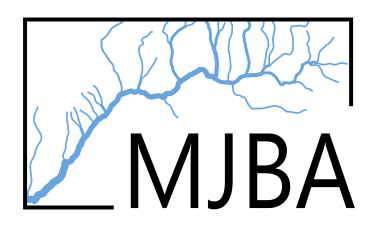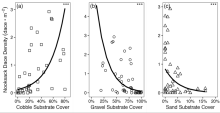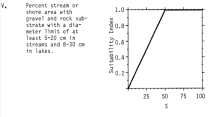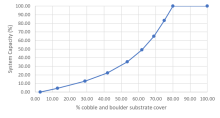Substrate Cover and Nooksack Dace
mbakken
View all records in the stressor response library
Species Common Name
Nooksack Dace
Latin Name (Genus species)
Rhinichthys cataractae
Stressor Name
Substrate Cover
Specific Stressor Metric
Percent Cobble and Boulder Cover
Stressor Units
% Cobble and Boulder Cover
Vital Rate (Process)
System capacity
Geography
Lower Fraser Valley (British Columbia)
Detailed SR Function Description
The final curve was based on relationship between % cobble substrate cover and Nooksack Dace density identified in Gray et al. (2024) using empirical data. We capped the maximum habitat capacity at 80% to prevent unrealistically high predicted capacity using the Gray et al. (2024) power function between dace density and % cobble. (see Fig. below). The habitat suitability curve for Longnose Dace (Edward et al., 1983) also generally supports a positive association between % cobble cover and system capacity. Note that while there is a generally positive overall relationship between cobble substrate and dace density, the variance around the line is large, particularly at higher cobble substrate cover. While we can be reasonably confident that dace abundance increases up to 20-40% cobble cover, it could also be reasonable to assume that it plateaus above this level as implied by the Edwards et al. (1983) curve for Longnose dace. At the expert elicitation workshop held in November 2024, John Gray indicated that Dace may even prefer larger substrate (i.e. boulder) and that a SR for boulder would be similar to the one for cobble. Therefore, for the x-axis of this SR function %cobble and boulder combined is more appropriate for more general application to streams/reaches that actually have boulder-sized substrate present.
Function Derivation
Based on data from Longnose Dace and Nooksack Dace; Empirical data (correlative model); Published
Transferability of Function
As local adaptations are likely minimal among different Nooksack Dace populations, we would not expect much variation in true tolerance among populations. This function should therefore be broadly applicable to all populations of the species with caution.
Source of stressor Data
Percent cobble substrate data is available for most (but not all) reaches in Bertrand, Pepin, Fishtrap Creeks, and the Salmon River, collected as part of Pearson (2004) and subsequent field work to define critical habitat for Nooksack dace.
Function Type
continuous
Stressor Scale
linear
References Cited
Usoof, A.M. and Rosenfeld, J.S. 2024. Relationship between system capacity and Percent Cobble Substrate Cover for Nooksack Dace.
Gray, J., J. Rosenfeld, M. Pearson, K. Colletti, and J. Ross. 2024. The effect of riffle restoration on the recovery of endangered Nooksack Dace (Rhinichthys cataractae sp. cataractae). Facets 9:1–15.
Gray, J., J. Rosenfeld, M. Pearson, K. Colletti, and J. Ross. 2024. The effect of riffle restoration on the recovery of endangered Nooksack Dace (Rhinichthys cataractae sp. cataractae). Facets 9:1–15.
File Upload
Nooksack Dace - Substrate Cover documentation
(279.52 KB)
Stressor Response csv data
Data_ND_Substrate_0.csv
(277 bytes)
| % Cobble and boulder | Mean System Capacity (%) | SD | low.limit | up.limit |
|---|---|---|---|---|
| 3.00 | 0.00 | 0 | 0 | 100 |
| 13.00 | 4.50 | 0 | 0 | 100 |
| 29.00 | 12.73 | 0 | 0 | 100 |
| 42.00 | 22.13 | 0 | 0 | 100 |
| 53.50 | 35.07 | 0 | 0 | 100 |
| 62.00 | 49.06 | 0 | 0 | 100 |
| 69.00 | 64.80 | 0 | 0 | 100 |
| 75.00 | 83.33 | 0 | 0 | 100 |
| 80.00 | 100.00 | 0 | 0 | 100 |
| 100.00 | 100.00 | 0 | 0 | 100 |
Stressor Response Chart



